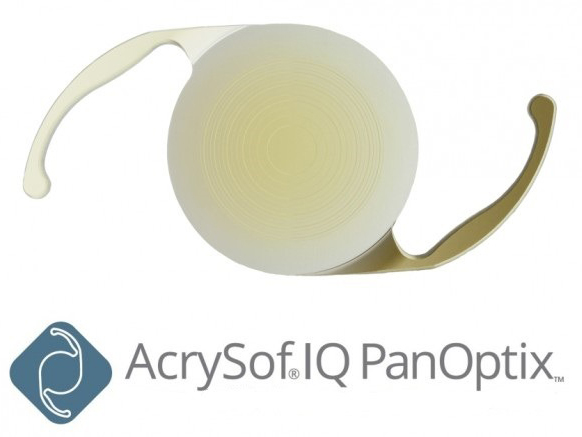If you need cataract surgery, your eye doctor may have suggested a premium IOL. Associates in Ophthalmology are now offering our cataract patients throughout the Livingston and New Jersey areas the revolutionary PanOptix trifocal Lens.

You may have questions about this new lens.
We’ve prepared this FAQ to help you understand the benefits of the PanOptix.
If you’re considering having cataract surgery in Livingston, contact Associates in Ophthalmology, Schedule an Appointment.
Why do I need cataract surgery?
As you age, the lens in the front of your eye gets cloudy. While you don’t feel any pain, you may notice your vision is hazy or blurry. You may also see spots in front of your eyes, or you may be more sensitive to glare.
During cataract surgery, your doctor removes the cloudy lens and replaces it. The replacement lens is called an intraocular lens, or IOL for short.
What is the PanOptix trifocal IOL?
The PanOptix Trifocal IOL is the first and only trifocal lens approved for use in the United States. The trifocal lens provides the best combination of near, intermediate and distance vision. Many patients who receive the PanOptix trifocal IOL find they rarely need to wear glasses.
Patients who receive a monofocal lens, on the other hand, find they can see well at a distance. These patients usually need glasses to see things that are at a close or intermediate range. For instance, they may need glasses or contact lenses to read a book or to see their computer screen clearly.
The PanOptix trifocal IOL is the only lens that provides seamless vision for patients at all distances. This includes near, far, and intermediate vision. All vision is clear at all times, no matter the distance, situation, or lighting.
Are there other benefits to the PanOptix trifocal IOL?
Besides enhancing the range of your vision, the PanOptix trifocal lens can also improve the quality of your vision. Studies show that patients who receive the PanOptix lens say their vision is sharp and clear. Patients also report that:
- There are no blurry zones, so you don’t have to strain to focus.
- Colors look bright and vivid.
- Glare around bright lights is less of a problem.
- About 80% of recipients reported they rarely have to wear eyeglasses.
With enhanced vision, people say they feel happier. People are also more likely to be active because they can see better in all lighting conditions. Being active can improve your general health.
You’re most likely to get the full benefit of the PanOptix trifocal lens when doctors place them in both eyes.
Can the PanOptix trifocal lens correct my astigmatism?
Astigmatism is an imperfection in the curve of your eye’s lens or cornea. Astigmatism can distort your vision or make objects look blurry.
It can affect your vision whether objects are close by or far away. About 70% of people who have cataracts also have astigmatism.
The PanOptix trifocal lens is available with an option designed to correct astigmatism. This kind of lens is called a toric lens.
By choosing this lens option, some patients with astigmatism no longer need glasses to see long distances. A toric IOL must be placed correctly in the eye to be effective.
What kind of record does the PanOptix trifocal lens have?
The PanOptix trifocal lens uses proven technology from Alcon, which is a global leader in eye care. The Food and Drug Administration approved the lens based on studies conducted in the United States.
The PanOptix trifocal lens is part of Alcon’s AcrySof IQ line of intraocular lenses. More than 120 million Alcon lenses have been implanted in eyes around the world. The PanOptix lens is one of the leading IOLs in more than 70 countries around the world.
The PanOptix trifocal IOL also uses proprietary ENLIGHTEN Optical Technology. ENLIGHTEN is a big part of what sets the PanOptix trifocal IOL apart from other lenses.
With ENLIGHTEN, there is a 40 cm (near) and a 60 cm (intermediate) focal point. Having a 60 cm focal point for intermediate vision, rather than 80 cm (which is the standard with other lenses), ensures that patients can easily complete tasks that are at arm’s length away. This includes things like reading a book, using a computer, or even watching television.
For the average person, arm’s length is closer to 60 cm away, rather than 80 cm away, which makes the PanOptix trifocal lens more comfortable.
Are patients happy with the PanOptix trifocal lens?
Yes. In fact, more than 99% of PanOptix patients say they would choose the same lens again.
Are there any possible side effects from the PanOptix trifocal lens?
Yes, as with any surgical procedure, there may be risks.
Some people who receive the PanOptix lens may have side effects. These include glare, rings around lights, and starbursts, or rays around light sources. They may also have difficulty distinguishing objects from their background. This lowered contrast sensitivity is most noticeable in low light.
With a success rate of 98%, cataract surgery is one of the safest surgeries performed in the United States. Eye surgeons in the U.S. perform more than 4 million cataract surgeries each year.
Be sure to discuss any concerns you have about cataract surgery with your eye doctor. Are you in Livingston and in need of a cataract surgeon? Contact Associates in Ophthalmology today to discuss all the options available to you.
How long do replacement lenses last after cataract surgery?
IOLs are very durable. In fact, it’s likely they will last the rest of your life, which is why it is important to select the best IOLs for your eyes.
There are many different lenses available. Ask your ophthalmologist about their recommendations for cataract replacement lenses.
Does the possibility of having clear vision at all distances appeal to you?
Schedule a cataract screening at Associates of Ophthalmology in Livingston, NJ to find out if the PanOptix trifocal lens could be right for you!

